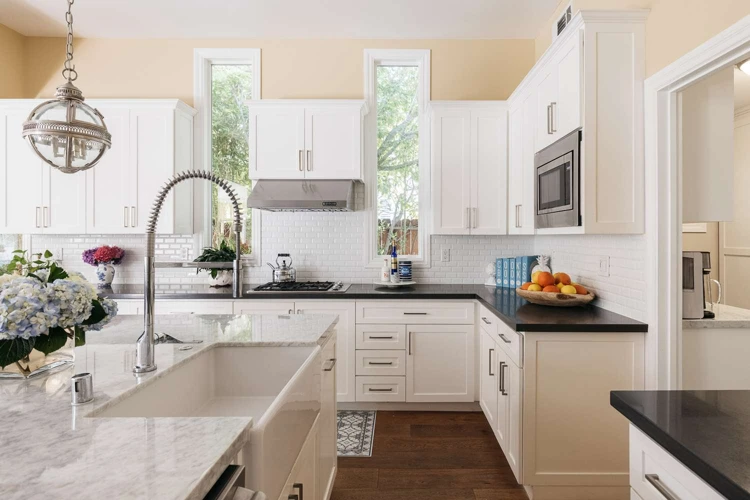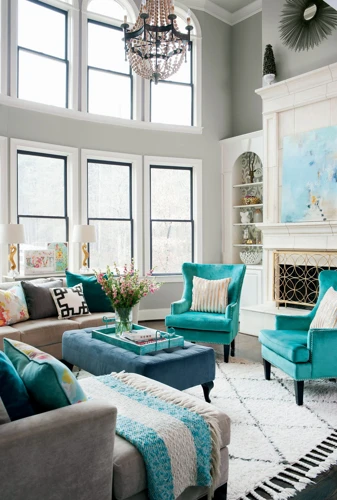Color is more than a visual experience; it is also a psychological one that can significantly affect mood and emotion in interior design. Understanding the color psychology in interior design is crucial for creating the desired atmosphere in any given room. Each hue has the power to evoke different responses, and the right choice can transform a space entirely.
The Impact of Color on Room Atmosphere
The ambiance of a room can be dramatically altered with the application of color. Light shades can make a space feel larger and airier, while darker tones tend to create a more intimate and cozy atmosphere. Colors can stimulate, energize, or calm the mind, influencing how people feel within the space.
Warm vs Cool Colors: Setting the Tone for Your Space
The temperature of color plays a pivotal role in interior design. Warm vs cool colors have the ability to evoke different emotions and set the tone for a space. Warm colors, such as reds, yellows, and oranges, can create a sense of comfort and warmth, while cool colors like blues, greens, and purples typically promote a calm and serene atmosphere.
Exploring Color Families for Decorating
The use of color families for decorating is a fundamental aspect of creating a harmonious interior. By selecting colors that naturally complement each other, you can develop a cohesive and visually appealing design scheme.
Defining Color Theory for Home Decor
Color theory for home decor is the science and art of using color. It explains how colors interact, their visual effects, and how they can be combined to create different moods and styles in home decorating. Understanding this theory is crucial when curating your interior color palettes.
How to Use Color Schemes to Enhance Your Home
Implementing a well-thought-out color scheme can completely transform a home. To enhance your home effectively, consider using a color wheel as a guide to select complementary, analogous, or triadic color schemes that can bring a room to life.
Choosing Room Colors for Every Space
The task of choosing room colors can be daunting, but it’s essential for creating the desired mood in each area of your home. Consider the function of each room and the feeling you wish to evoke when selecting hues.
Best Colors for Room Atmosphere
Best colors for room atmosphere often include calming blues and greens for bedrooms, vibrant yellows or oranges for living areas, and neutral tones for spaces requiring versatility. Each color can craft a distinct environment, whether you’re seeking tranquility or vitality.
Neutral Color Schemes for Rooms
Neutral color schemes for rooms offer timeless elegance and flexibility. They serve as the perfect backdrop for both bold accents and subtle decor, making them a popular choice for homeowners seeking a versatile and sophisticated look.
Creating Cohesive Interior Color Palettes
Creating interior color palettes that are cohesive can make your home feel balanced and put together. Coordinating colors throughout your home can create a sense of flow and unity.
Combining Colors for a Balanced Look
To achieve a balanced look, consider combining a mix of complementary and analogous colors. Use the 60-30-10 rule as a guideline: 60% of the room should be a dominant color, 30% a secondary color, and 10% an accent color.
Paint Color Ideas for Home: Inspiration and Trends
Keeping up with the latest paint color ideas for home can provide inspiration and keep your interiors feeling fresh and modern. Explore current color trends, such as earthy tones and bold, saturated hues to find the perfect fit for your space.
Room Color Schemes: Practical Tips and Ideas
Creating effective room color schemes requires a blend of creativity and practicality. Use these tips and ideas to guide your color choices and create a space that feels both personal and professionally designed.
How to Build a Layered Palette for Depth and Interest
- Start with a base color that sets the overall mood.
- Add a secondary color for variety and contrast.
- Introduce accent colors through accessories and artwork.
- Consider texture and patterns to add depth.
Embracing Color Trends in Family Rooms
Family rooms are the perfect place to embrace color trends. These spaces benefit from energetic and inviting colors that encourage conversation and togetherness. Consider using trending shades that reflect the personality of your family.
Creating Contrast with Dynamic Color Combinations
To create visual interest, consider using dynamic color combinations that offer contrast. Pairing a bright color with a neutral, or a warm color with a cool one, can make design elements pop and give your room a modern edge.
Best Practice for Choosing Room Colors
When it comes to choosing room colors, there are several best practices to consider. These ensure that the colors you select will serve your space well, both aesthetically and functionally.
Color Drench Trend: What It Is and How to Implement It
The color drench trend involves using varying shades of the same color to saturate a room, creating a bold and cohesive look. Implement this trend by choosing different tones of your chosen color for walls, furniture, and accessories.
Introducing Vibrancy vs. Subdued Elegance in Room Schemes
Deciding between vibrancy and subdued elegance can be a matter of personal preference and the function of the room. Vibrant colors can energize a space, while subdued tones can convey a sense of sophistication and calm.
Paint Color Ideas for Home: A Room-by-Room Guide
Considering paint color ideas for home on a room-by-room basis is a great approach to ensure that each space functions as intended. Here’s a quick guide to get you started on your color journey.
Living Room Color Inspirations
The living room is where you entertain and relax, so choose colors that create a welcoming and comfortable environment. Earth tones, soft blues, or even a bold accent wall can provide the perfect setting for your living space.
Bedroom Colors for Relaxation and Energy
Your bedroom is your sanctuary. Opt for calming colors like lavender or soft green for a restful night’s sleep, or if you’re looking for more energy, consider cheerful colors like coral or sky blue.
Kitchen and Dining Area: Colors for Appetite and Socializing
Kitchens and dining areas benefit from colors that stimulate appetite and social interaction. Shades of red and yellow can encourage eating and conversation, while green and blue hues can create a fresh and clean backdrop for meals.
When it comes to decorating small spaces, choosing the right color family can make all the difference in creating a sense of openness and style. To help you navigate through the myriad of options, we have some resources that will guide you in selecting the perfect hues. Dive into our article on color combinations for small rooms to understand which palettes can visually expand your space. Stay updated with the latest preferences in home aesthetics by exploring popular color trends for home interiors. And if you need a more focused guide, our tips on how to choose a color for a small room will ensure you make the most informed decisions for your cozy quarters.
Conclusion: Bringing Your Interior to Life with Color
In conclusion, the strategic use of color can bring your interior to life, reflecting your personality and enhancing your home’s overall aesthetic. With the principles of color psychology, color theory, and a thoughtful approach to selecting hues, you can create spaces that are not only visually pleasing but also emotionally resonant. Whether you’re a fan of bold and dynamic room color schemes or prefer neutral color schemes for rooms, the power of color in interior design is undeniable. So go ahead, experiment with different palettes and watch as your home transforms into a vibrant reflection of your unique style and vision.


